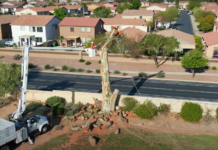The Ancient Ones, the Huhugam, are surely smiling. The Huhugam Heritage Center will be open to the public on Friday, September 10, 2004. The Center’s hours will be 10 a.m. to 4 p.m. every Tuesday through Saturday.
Located on the Gila River Community one mile west of Interstate 10 at the junction of Maricopa and Queen Creek Roads, the Center is located on 68 acres and includes a courtyard ethno-botanical garden based on the cultural significance of desert plants. The Heritage Center’s construction features tilt-panel walls and a central outdoor area reminiscent of Huhugam ball courts. Surrounding the Center is an earthen berm much like the rim of an olla or water jar with inner terracing patterned after the Huhugam’s agricultural lands.
 The structure covers 40,435 square feet with approximately half of that space devoted to artifact storage (archaeological collections from both the Central Arizona Project and the Gila River Indian Community lands), laboratories, and classrooms. The remaining square footage is divided almost evenly between a library, reading room, administrative offices and the museum with its exhibit gallery.
The structure covers 40,435 square feet with approximately half of that space devoted to artifact storage (archaeological collections from both the Central Arizona Project and the Gila River Indian Community lands), laboratories, and classrooms. The remaining square footage is divided almost evenly between a library, reading room, administrative offices and the museum with its exhibit gallery.
Scheduled for the September 10 opening, the newest exhibit, on loan from Arizona State Museum, is “With an Eye on Culture: The Photography of Helga Teiwes”. Ms. Tiewes documented the Native American and prehistoric cultures of the Southwest in her series of photographs taken between 1964 and 1993. Also on display will be murals by Pee Posh artist Amil Pedro and Mike Chiago a member of the Akimel O’odham Community. Later this fall several of the 84 baskets of the unique and nearly intact Breazale Collection that was acquired in 1997 will be displayed.
The
Huhugam Heritage Center will retain photographs, oral histories, and historical documents in its archives. The Center’s goal is to conserve and interpret the arts, history, and culture of the pre-historic Huhugam and the contemporary Akimel O’odham (Pima) and Pee Posh (Maricopa) Native peoples and to educate both Community members and visitors.


![Shred-A-Thon to take place tomorrow An image of shredded paper. [Pixabay]](https://www.inmaricopa.com/wp-content/uploads/2024/03/shredded-paper-168650_1280-218x150.jpg)













![Shred-A-Thon to take place tomorrow An image of shredded paper. [Pixabay]](https://www.inmaricopa.com/wp-content/uploads/2024/03/shredded-paper-168650_1280-100x70.jpg)
